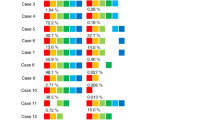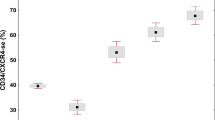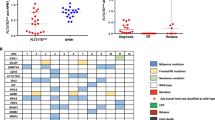Abstract
Apoptosis of hematopoietic progenitor cells is increased in myelodysplastic syndromes (MDS). We have studied Fas (CD95/Apo-1) antigen expression in 27 MDS patients (RARS 4, RA 3, RAEB 13; RAEB-t 3, CMML 4) and three AML secondary to MDS. We found that the Fas antigen was not expressed on normal bone marrow (BM) CD34+, CD14+, or glycophorin+ cells, and only slightly on CD33+ cells. Patients with MDS had upregulation of Fas expression on total bone marrow nuclear cells (BMMC) (t-test, P = 0.04), CD34+ (P = 0.013), CD33+ (P = 0.04), and glycophorin+ (P = 0.032) BM cells compared to controls. Fas expression did not correlate to the FAB subtype, the Bournemouth score, or to peripheral cytopenias. However, Fas expression intensity on CD34+ cells negatively correlated to the BM blasts number (Spearman, P = 0.01) suggesting that leukemic blasts cells lose Fas antigen expression with progression of myelodysplasia. Using both proliferation assays in liquid cultures and clonogenic progenitor assays in the presence of an agonist anti-Fas MoAb (CH11), we showed that the Fas protein was functional in some patients. Dose-dependent inhibition of DNA synthesis was observed in three out of seven patients studied. CFU-GM and BFU-E colonies suppression in some patients suggested that Fas can induce apoptosis in myeloid and erythroid BM progenitors of MDS patients. The TUNEL technique on BM smears gave a mean of 12.6% ± 2.5 of bone marrow apoptotic cells in five controls. Patients with MDS had increased bone marrow apoptosis (mean 39% ± 5.7, t-test, P = 0.012). Four out of 15 (26%) patients studied with a sensitive radiolabeled DNA ladder technique had typical DNA ladders indicative of advanced stages of apoptosis. Massive BM suicide was observed in patients with RA (2/2) and RAEB (8/11), whereas apoptosis rates were normal or low in patients with RAEB-t (3/3) or secondary AMLs (3/3). Moreover, high rates of apoptosis correlated to low Bournemouth score (Spearman, P = 0.01). No statistical correlation could be found between Fas expression and apoptosis rates. Our results confirm the importance of programmed cell death in MDS. The Fas antigen is clearly upregulated on BM cells, but its role in the pathophysiology of apoptosis in myelodysplasia is still unclear, indicating that many factors positively or negatively interfere with the Fas-mediated pathway of apoptosis in vivo and in vitro.
This is a preview of subscription content, access via your institution
Access options
Subscribe to this journal
Receive 12 print issues and online access
$259.00 per year
only $21.58 per issue
Buy this article
- Purchase on Springer Link
- Instant access to full article PDF
Prices may be subject to local taxes which are calculated during checkout
Similar content being viewed by others
Author information
Authors and Affiliations
Rights and permissions
About this article
Cite this article
Bouscary, D., De Vos, J., Guesnu, M. et al. Fas/Apo-1(CD95) expression and apoptosis in patients with myelodysplastic syndromes. Leukemia 11, 839–845 (1997). https://doi.org/10.1038/sj.leu.2400654
Received:
Accepted:
Issue Date:
DOI: https://doi.org/10.1038/sj.leu.2400654
Keywords
This article is cited by
-
Luspatercept (RAP-536) modulates oxidative stress without affecting mutation burden in myelodysplastic syndromes
Annals of Hematology (2022)
-
Disordered Immune Regulation and its Therapeutic Targeting in Myelodysplastic Syndromes
Current Hematologic Malignancy Reports (2018)
-
Management of anemia in low-risk myelodysplastic syndromes treated with erythropoiesis-stimulating agents newer and older agents
Medical Oncology (2018)
-
PP2A inhibition from LB100 therapy enhances daunorubicin cytotoxicity in secondary acute myeloid leukemia via miR-181b-1 upregulation
Scientific Reports (2017)
-
Deregulation of innate immune and inflammatory signaling in myelodysplastic syndromes
Leukemia (2015)



